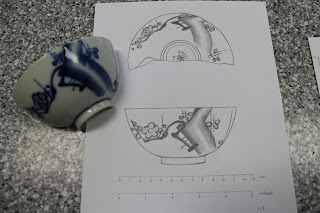Jasmin and Willow presented their reports on the "garden/rock" features; concluding that Willow's area was most likely a garden (due to the terrain, shape, and the amount of animal bone fragments found in the soil) and that Jasmin's rock feature was likely to have supported a structure of some kind, perhaps an open gazebo (lots of charred wood and nails were found in the excavation process). All in all, the projects and reports came together nicely and we are confidant that our contributions to the project will be very useful for future field schools.
One of the last days we were in the lab...seems like yesterday that we were learning each others' names!
The "P" building on the Capilano campus (where we store some of our archaeology supplies) is a little scary in some areas as it is quite an old building with some strange contents. So creepy in fact, that Ryan, Andrew, and Nathan decided to do their best impression of a zombie apocalypse attack. An appropriately silly moment to commemorate the completion of packing away our gear.
I was very happy to report to Bob that this blog has received over 3,000 viewers from 20 different countries worldwide (including Russia, Lithuania, New Zealand, Philippines, Italy, Zimbabwe, and Argentina to name a few).
We all felt a tinge of sadness on our last day together...none of us seemed ready for the program to be over. We have all gotten to know each other quite well and it's clear that we all would have been happy to spend another 6 weeks working with one another. Alas, it was time to say goodbye so we all went out for lunch at a restaurant just down the road from campus. Bob said it was the first time in the program's history that all 15 field school students had gotten together for a social gathering. I have a feeling that the friendships we have developed as a crew will last for a long time.
Thank you to all of the readers and supporters (family, friends and colleagues) of the blog and the field school itself. It was an experience that our entire crew will never forget.













.JPG)







